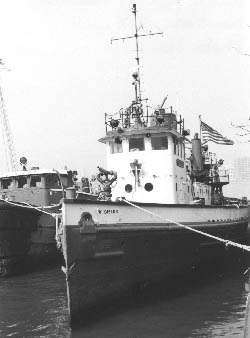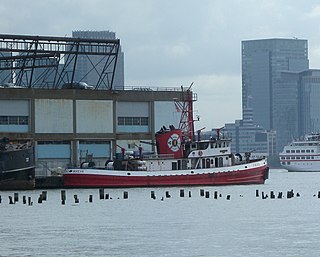
The September 11 attacks on the World Trade Center elicited a large response of local emergency and rescue personnel to assist in the evacuation of the two towers, resulting in a large loss of the same personnel when the towers collapsed. After the attacks, the media termed the World Trade Center site "Ground Zero", while rescue personnel referred to it as "the Pile".

The New York City Fire Department, officially the Fire Department of the City of New York (FDNY) is the full-service fire department of New York City, serving all five boroughs. The FDNY is responsible for fire suppression and fire prevention, and is a major provider of EMS services in New York City. Beyond fire suppression and EMS, the FDNY is responsible for a broad range of services, including technical rescue, CBRN defense, and structural collapse response and analysis. The FDNY is equipped with a wide variety of general-purpose and specialized Vehicles,Tools and Equipment to serve its varied missions.

The MV Andrew J. Barberi is one of two Barberi-class ferry boats operated as part of the Staten Island Ferry between Manhattan and Staten Island in New York City, besides MV Samuel I. Newhouse. With a capacity of 6,000, she is among the highest-capacity boats in the ferry's fleet. Since her introduction in 1981, she has had a history of incidents, including a 2003 crash that killed eleven people and a 2010 crash that injured thirty-seven.

A fireboat or fire-float is a specialized watercraft with pumps and nozzles designed for fighting shoreline and shipboard fires. The first fireboats, dating to the late 18th century, were tugboats, retrofitted with firefighting equipment. Older designs derived from tugboats and modern fireboats more closely resembling seafaring ships can both be found in service today. Some departments would give their multi-purpose craft the title of "fireboat" also.

NY Waterway, or New York Waterway, is a private transportation company running ferry and bus service in the Port of New York and New Jersey and in the Hudson Valley. The company utilizes public-private partnership with agencies such as the Port Authority of New York and New Jersey, New Jersey Transit, New York City Department of Transportation, and Metropolitan Transportation Authority to provide service and maintain docking facilities.

SLNS Vijayabahu (P627) is an Advanced Offshore Patrol Vessel of the Sri Lanka Navy. The ship is named after King Vijayabahu I, the warrior king of the medieval Sri Lanka who founded the Kingdom of Polonnaruwa.

USCGC Dallas (WHEC-716) was a United States Coast Guard high endurance cutter commissioned in 1967 at the Avondale Shipyard in New Orleans, Louisiana. She was the sixth ship or boat to bear the name of Alexander J. Dallas, the Secretary of the Treasury under President James Madison (1814–1816). She is one of twelve Hamilton-class cutters built for the Coast Guard.

John J. Harvey is a fireboat formerly of the New York City Fire Department (FDNY) in New York City, famed for returning to service following the September 11, 2001 attacks. She is one of the most powerful fireboats ever built, capable of pumping up to 18,000 gallons of water a minute.

USCGC Balsam (WLB-62) was a Cactus-class seagoing buoy tender (WLB) in the United States Coast Guard. She operated in the Pacific Ocean during World War II, then saw service along the United States West Coast, Hawaii, and Alaska. After her decommissioning in 1975, she was repurposed as a crab catcher-processor and is active in Alaskan fisheries as F/V Baranof.
The history of the United States Coast Guard goes back to the United States Revenue Cutter Service, which was founded on 4 August 1790 as part of the Department of the Treasury. The Revenue Cutter Service and the United States Life-Saving Service were merged to become the Coast Guard per 14 U.S.C. § 1 which states: "The Coast Guard as established January 28, 1915, shall be a military service and a branch of the armed forces of the United States at all times." In 1939 the United States Lighthouse Service was merged into the Coast Guard. The Coast Guard itself was moved to the Department of Transportation in 1967, and on 1 March 2003 it became part of the Department of Homeland Security. However, under 14 U.S.C. § 3 as amended by section 211 of the Coast Guard and Maritime Transportation Act of 2006, upon the declaration of war and when Congress so directs in the declaration, or when the President directs, the Coast Guard operates as a service in the Department of the Navy.

Fire Fighter is a fireboat which served the New York City Fire Department from 1938 through 2010, serving with Marine Companies 1, 8 and 9 during her career. The most powerful diesel-electric fireboat in terms of pumping capacity when built in 1938, Fire Fighter fought more than 50 major fires during her career, including fires aboard the SS Normandie in 1942 and the SS El Estero in 1943, the 1973 collision of the Esso Brussels and SS Sea Witch, and the terrorist attacks on September 11, 2001.

The third USS Calypso (AG-35) was launched 6 January 1932 for the United States Coast Guard as USCGC Calypso (WPC-104) by the Bath Iron Works in Bath, Maine. She was initially stationed at San Diego, California, and transferred to Baltimore, Maryland in 1938. She was transferred from the Coast Guard to the U.S. Navy on 17 May 1941 and commissioned the same day.

John D. McKean is a fireboat that served the New York City Fire Department as Marine Company 1. She is named after John D. Mckean, who died in a 1953 steam explosion while trying to save a predecessor fireboat, the George B. McClellan.

Three Forty Three is a Ranger 4200 class fireboat that serves the New York City Fire Department as marine company 1. Designed by Robert Allan Ltd. and built to replace the 1954 John D. McKean. It was commissioned at 0900 hours on September 11, 2010, exactly nine years after the 2001 terrorist attacks. It is one of the four New York fireboats currently active in service.

USCGC Adak (WPB-1333) was a United States Coast Guard cutter that received her name from Adak Island in the Aleutian Islands of Alaska. Built at Bollinger Shipyard in Lockport, Louisiana, Adak was placed in commission on 18 August 1989 in New Jersey and decommissioned on 30 June 2021 in Manama, Bahrain after almost 32 years of service.
For much of the late 19th and early 20th century, New York City maintained a fleet of ten fireboats. In recent decades technology has improved to where smaller boats can provide the pumping capacity that required a large boat in the past. These smaller boats require smaller crews, and the crews themselves require less training. Like many other cities the FDNY operates a fleet with a smaller number of large fireboats, supplemented by a number of unnamed boats in the 10 meter range.

The Kevin C. Kane was formerly an FDNY fireboat and is currently being refitted as a long-haul tugboat. She was built by Gladding-Hearn Shipbuilding in Somerset, Massachusetts, and delivered on December 8, 1992. She participated in two high-profile events: responding to al Qaeda's attack on the World Trade Center, on September 11, 2001; and the rescue of passengers from US Airways Flight 1549, the airliner that landed on the Hudson River in January 2009. She was auctioned off after she incurred damage during Hurricane Sandy. The vessel was named after a firefighter who lost his life in the line of duty.

USCGS Katherine Walker (WLM-552) is a Keeper-class coastal buoy tender of the United States Coast Guard. Launched in 1996, she has spent her entire career homeported at Bayonne, New Jersey. Her primary mission is to maintain 335 aids to navigation in New York Harbor, Long Island Sound, and surrounding waters. She is assigned to the First Coast Guard District.
The Alfred E. Ronaldson was a fireboat operated briefly by the Fire Department of New York City in 1994. The boat was named after a firefighter who lost his life in the line of duty.

















